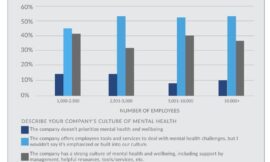
Australia is in a position where it could have a highly diverse IT sector across all lines — gender, sexuality, ethnicity, physical ability and age. Currently, however, it has struggled to convert its significantly diverse culture into diversity in the tech sector.
This lack of diversity can limit innovation, inclusivity and productivity, so there is a significant opportunity in taking steps, from driving better human resources policies to organising better at the grassroots level to address this challenge.
Jump to:
The current state of diversity in Australian organisations
In Australia, women constitute 38.4% of all full-time employees and 68.5% of all part-time employees. However, these figures are not mirrored in the IT sector — or any other STEM-based sector in Australia.
Women make up only around 37% of enrolments in university STEM courses, and only hold around 15% of STEM-qualified jobs. The shortfall applies to leadership positions too, where only 23% of senior managers in STEM-qualified industries are women, and just 8% of these companies have a woman as the CEO.
While the focus on diversity in IT is often on the importance of bringing more women into STEM roles, Australia is also challenged by a lack of ethnic diversity, too. The government is opening the country to more Visas for migrant tech professionals and is on track to reach its goal of 1.2 million tech workers by 2030. Another opportunity that could achieve a lot for the good of society is to better engage with First Nations people. Currently, just 0.5% of First Nations people hold university-level STEM qualifications, and in a nation that is grappling with how to better collaborate with its First Nations people, improving their access to STEM education and career paths would be a good step.
However, to continue this good momentum, as the Tech Council acknowledges, Australia needs to continue to take positive steps around diversity, both in terms of supporting the domestic population and bringing in more talent from overseas.
“We’re pursuing work towards industry-led solutions, like improving diversity in the tech sector,” the Council notes. “With strong growth and continued commitment, the tech sector is poised to be a significant contributor to Australia’s future economic prosperity.”
Diversity drives innovation
Addressing the skills shortage, is not the only benefit of encouraging a more diverse workforce.
Rather, as the Tech Council article alludes to, diversity in employee demographics brings diversity of thought. The need for that is rapidly approaching the point where it’s urgent, as there are applications and innovations in development right now that are simply going to fail to perform to expectations without the check that diversity puts on development.
In an interview with Forbes, Miranda Ratajski, the CIO of Westpac, one of Australia’s big four banks, explained the problem in very simple terms: “the best products and services are designed by teams that look like our customers.”
SEE: Discover how fintech startups are shaking up the industry in Australia.
Women comprise 51% of the Australian population, and 30% of the population are migrants. Companies need these voices at the table as they start to create applications that “speak” directly to customers.
“When I think about artificial intelligence, the data that goes in to help make business decisions is so incredibly important,” Ratajski said in the interview. “The best way to look after our customers is to have teams who understand them and make sure we can give them what they need.”
Another good example of the value of having diversity in IT is that it leads to new solutions to problems. As one feature noted, startups that are run by women tend to be focused on developing sustainable energy solutions, reducing waste and improving access to services in underserved communities. And yet, startups that are run by women receive just 0.7% of total venture capitalist investment in Australia.
As Australia continues to look for innovations and encourage a startup and entrepreneurial culture, providing an environment that encourages different ideas, right down to the ability to identify problems in the market, will be critical.
Advocacy can help
Addressing the challenge of encouraging diversity in IT careers is one area where everyone, from the senior executive down to rank-and-file employee, can be part of the solution. At a policy level, there are some major innovations being considered.
In addition to opening the country up to a broader range of STEM skills, lobbying groups are recommending the use of tax incentives as a way of encouraging companies to rapidly shift the demographic make-up of their IT teams.
At a more grassroots level, however, those from minorities within IT — including women, non-white ethnic people, those from the LGBT+ community and those with physical or mental disabilities — continue to struggle with workplace bias and difficulties with career progression. Mentoring opportunities, for example, tend to be difficult to come by, as are resources and career advice.
However, IT professionals can be part of the solution by advocating for more opportunities to encourage diversity, equity and inclusion and protect underrepresented individuals in the tech industry.
Promote inclusive hiring practices
Advocating for hiring practices that actively seek out and welcome candidates from diverse backgrounds is something that can be done at all levels. This could include reaching out to underrepresented groups to make them aware of job openings, using inclusive language in job descriptions and implementing unbiased screening processes.
Encourage continuous learning and education
Most organisations support staff to understand ongoing learning and courses. Making learning about diversity and inclusion part of that will help build an overall culture that supports diversity. This could involve diversity training programs, workshops or bringing in speakers to discuss these topics, and workers should push back at any suggestion that this education isn’t related to their job roles.
Foster an inclusive culture
Every employee has an obligation to create a workplace culture that values and respects diversity. This can be achieved by promoting open dialogue, celebrating different cultures and experiences and implementing policies that prevent discrimination.
Unionise
Finally, having a strong union in the workplace can be incredibly effective in promoting diversity and inclusion. Unions focus on equal treatment and opportunity for all, and can help ensure the underrepresented demographics in an organisation have the same opportunities in mentorship and career development as others. Furthermore, unions give those who feel like they’re in the minority a platform to speak out.
A major opportunity — with the right focus
All organisations and IT teams benefit from promoting a diversity of thought and action within their organisations. While there is work being done at the top levels to grapple with Australia’s ongoing challenges with diversity, there’s also a lot that can be down at the grassroots level to support diversity and ensure that the intentions of organisations to promote diversity are being followed through with.
Source of Article



